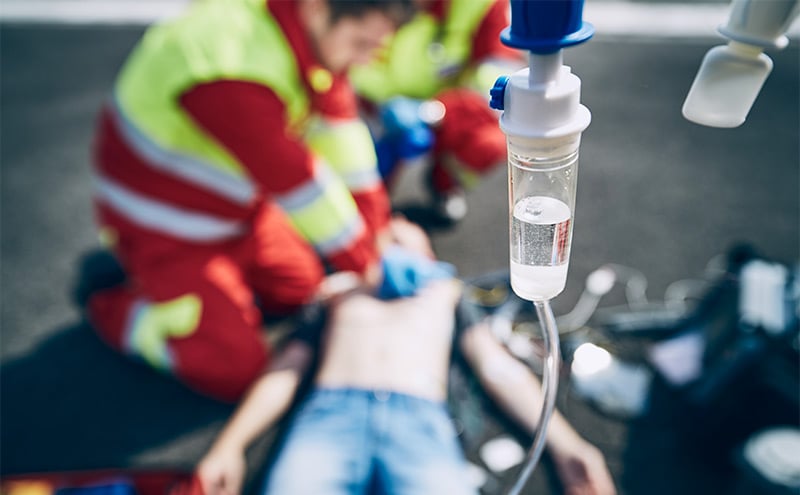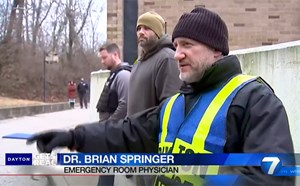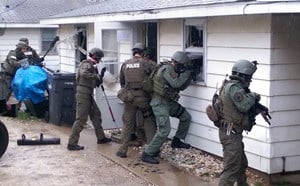
Prehospital Fluid Resuscitation
Case Report From Field
A 60 year-old male was shot with a 12 gauge rifled slug through his car door after stopping at a car wash on his way home from work. 30 minutes before on an interstate miles away, the assailant believed the patient had changed lanes too quickly in front of him. While the assailant’s girlfriend and child watched, he observed the patient at a gas station before engaging the patient with a shotgun. The patient had a wound in the left abdomen with no associated companion wounds present. The patient called 911, but didn’t know his location and couldn’t read signage with rapidly dimming vision. He hung up while calling his daughter and trying to drive the short distance home. She encountered him along the road in severe distress and called 911 at 1751.
Constable deputies arrived at 1754, followed by a basic life support engine company from the local fire department at 1757. The EMS paramedic ambulance arrived at 1758. Within two minutes, the patient was loaded while the crew considered rapid transport to a Level II trauma center approximately 15-20 minutes away. The paramedic supervisor was also en-route, and carried two units of Low-Titer O Whole Blood (LTOWB). He ascertained the patient was in hemorrhagic shock and had the crew pull over at a gas station where they intercepted at 1804 with plan for helicopter evacuation to a Level I trauma center (at least 45-60 minutes away by ground) due to severity of injury. A chest seal had been applied to the penetrating wound, monitoring devices applied, and peripheral IV’s started. Heart rate was 130, blood pressure 70/30. The patient was cool, pale, and diaphoretic while awake but poorly interactive. The prehospital physician had self-assigned to the call earlier and arrived at 1805. A 9F single-lumen Percutaneous Sheath Introducer was placed by the physician in the left subclavian vein using landmark technique under non-sterile conditions within 90 seconds of opening the kit. Blood tubing and warmer were prepared and primed concurrent to line placement. Transfusion was initiated with the support of a pressure bag. 1 gram of Calcium Chloride was administered along with 25 mg of Ketamine for pain control.
Blood pressure and heart rate did not improve, and the second unit was initiated while the patient’s mental status progressed to minimal groaning to painful stimulus. Due to shock and already poor responsiveness, a paralytic only intubation with Succinylcholine was performed in the ambulance shortly after arrival of the MEDEVAC helicopter platform at 1819. A second unit of LTOWB was completed at that time. An orogastric tube aspirated blood, and a FAST exam demonstrated free fluid in the abdomen. Two units of Packed Red Blood Cells and two units of Fresh Frozen Plasma were administered in the air. The patient arrived at the receiving hospital helipad at 1829 and was transferred immediately to the Operating Room, bypassing the Emergency Room/Trauma Bay utilizing a new “Direct to OR” protocol. The patient received over 40 units of additional blood products during the damage control laparotomy. The slug was found to have penetrated the spleen and stomach prior to lodging in the liver. The patient rapidly improved in the Surgical Intensive Care Unit and progressed to return home two weeks later.
Conclusion
The patient soon returned to work at his job at an environmental services company. He asked for the contract sanitizing EMS stations during the COVID-19 pandemic because he felt that the prehospital care had saved his life. It was during the course of these visits – local fire and EMS leadership learned it was the same person who had been treated several months before. On 05 June 2020, an event was held to reunite the law enforcement, fire, EMS, and hospital personnel. The author greatly enjoyed the opportunity to meet the patient under better circumstances.
Lessons Learned for the Tactical Setting
Prehospital physicians are nothing new to law enforcement medical support. However, the availability of blood products in the civilian prehospital setting is very new and changes the paradigm of “permissive hypotension” and minimal fluid resuscitation. Every effort should be made to secure blood products, optimally LTOWB, as this is the optimal resuscitation fluid available.1 If unable to secure blood products, 25% albumin provides the next most efficacious alternative with no special storage requirements.2,3
Tactical physicians should strongly consider central venous access in the setting of severe trauma necessitating a prehospital blood transfusion. Prehospital physicians have been demonstrated to be able to rapidly place central venous access in the field.4 It appears likely to the author that those patients who require prehospital blood transfusion will be more likely to require massive transfusion as their earlier demonstration of the signs and symptoms of hemorrhagic shock portends more serious injuries. Thus, they will likely benefit from early large-bore vascular access, volume resuscitation, and adjunctive therapies such as Calcium Chloride and Tranexamic Acid.
About the Author
Nicholas Studer is a Fellow in the EMS/Disaster Medicine Fellowship at Brooke Army Medical Center, Fort Sam Houston, TX. He graduated Emergency Medicine residency and the Transitional internship at Brooke Army Medical Center, with an interlude as Flight Surgeon and Multinational Force & Observers South Camp Dispensary Chief in Sinai, Egypt. Before medical school at the University of South Florida, he was a paramedic and HazMat Specialist.
The view(s) expressed herein are those of the author(s) and do not reflect the official policy or position of the U.S. Army Medical Department, the U.S. Army Office of the Surgeon General, the Department of the Army and Department of Defense, or the U.S. Government.
References
- Butler FK, Holcomb JB, Schreiber MA, et al. Fluid Resuscitation for Hemorrhagic Shock in Tactical Combat Casualty Care: TCCC Guidelines Change 14-01--2 June 2014. J Spec Oper Med. 2014;14(3):13-38.
- Studer NM, April MD, Bowling F, Danielson PD, Cap AP. Albumin for Prehospital Fluid Resuscitation of Hemorrhagic Shock in Tactical Combat Casualty Care. J Spec Oper Med. 2017;17(2):82-88.
- Kheirabadi BS, Miranda N, Terrazas IB, et al. Should Albumin Be Considered For Prehospital Resuscitation in Austere Environments? A Prospective Randomized Survival Study in Rabbits [published online ahead of print, 2019 Nov 15]. Shock. 2019;10.1097/SHK.0000000000001480. doi:10.1097/SHK.0000000000001480
- Fyntanidou B, Fortounis K, Amaniti K, et al. The use of central venous catheters during emergency prehospital care: a 2-year experience. Eur J Emerg Med. 2009;16(4):194-198. doi:10.1097/MEJ.0b013e32831270c4
Nicholas M. Studer MD



